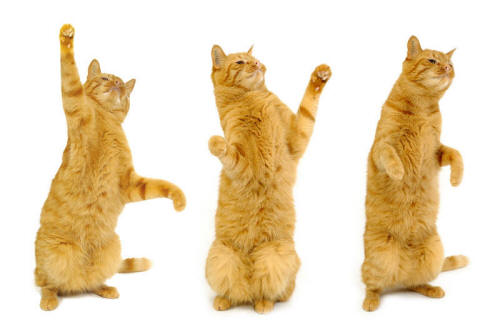|
Other training rewards include squeaky mouse toy, balls, praise, petting or anything the cat perceives as a reward.
|
How is food used?
It is important to understand the difference between
using food as a bribe and using
food as a paycheck or salary
Using
food, one can usually show the
pet what behavior is desired by
moving the food where one wants
the cat to go. For example, if
food is moved skillfully up and
back over a hungry cat's head,
the cat will find it easier to
reach the food by sitting.
Releasing the food treat when
the cat sits - over time -
teaches the cat that sitting is
one way to earn a food reward.
ALWAYS praise correct responses
as you provide the food as over
time the pet will not get food
every time but will be
reinforced with your praise for
a job well done.
|
Food is the currency of life. You
exchange food for your cat
doing certain behaviors. This
is a win-win for you both!
|
Using food
as a lure
Begin by holding the treat on the nose or
at the lips so that your cat attempts to nibble it. Once
your cat is trying to nibble the food, move the food to lure (move)
your cat into the position you want.
For example, move the food forward and
your cat will walk forward. Move the food back to tilt
your cat's head back so that eventually
your cat will sit. Move the
food up and your cat will sit
up. Luring your cat into position to teach what one word means is a terrific use of food.
Using food
as a reward
Once
you have moved the cat into the
desired position, releasing to
food becomes the reward and the
reinforcer for this new desired
behavior. The food becomes the paycheck for doing the job!
|
End training sessions prior to your cat getting bored or frustrated. Try
to end with a positive note and best response.
.
|
Using
food as a reminder
Give a food reward
every time when the cat is
learning a new behavior to make
each lesson clear and to
reinforce what you want.
Remember pets learn to follow
body signals much faster than
they learn to associate a verbal
cue with a desired behavior. To
speed up learning choose one
clear hand signal for each
behavior you want to teach that
resembles the way your lure the
pet into the position.
After the pet
will follow instructions
reliably for either food, hand,
or verbal signals, then you are
ready to begin to phase out
giving food rewards for each
success. Start by giving food
for every other success and for
the best responses. Then vary
when you offer food but only
give food for the best
responses.
Use food to "tune
up" learning and keep training
fun for your pet!
TEST:
After your cat has learned to follow your hand each time by sitting to get the
food reward, you can begin to lure with an empty hand and have the reward ready
in the other hand. As the cat learn to sit following your hand motion, begin to
add the word, "Sit." It takes pet MUCH longer to learn verbal human language
than it does for them to learn body language so be patient. Once your cat
follows your cue reliably, you will know if food is a paycheck or bribe.
If you cat ONLY sits when the cat knows you have food, then it is a bribe. If
the cat sits expecting food and you give it on a varying schedule, then you will
know your cat is trying to earn a paycheck.
